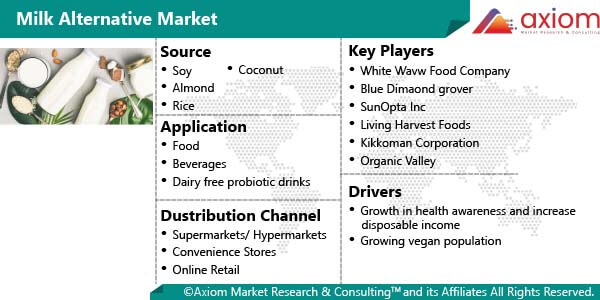Milk Alternatives Market Segmental Overview
The milk alternatives market is segmented by type, applications, sales channel and geography.
Milk Alternatives Market by Type
Various types of milk alternatives were studied in this report such as almond milk, soymilk, oat milk, hemp milk, coconut milk and rice milk. Soy milk consist of beneficial isoflavones, which assists in prevention of breast cancer and heart diseases. This property has led to its high acceptance among women. Whereas, due to the high content like protein, lipids and fiber, the almond milk segment is estimated to have a significant grow rate during the forecast period.
Milk Alternatives Market by Application
Based on applications the milk alternative market is divided into food and beverages segments. Further, the food segment is classified into cheese, creamer, yogurt, pudding and ice cream. Increase consumption of milk alternative based desserts, snacks and cheese, the food application segments is estimated to witness a stable growth rate. Furthermore, change in dietary preference of consumers and increase in consumption of fast food has increase the demand for lactose free cheese globally. Whereas, increasing demand of flavored milk products such as cashew, almond and walnut is projected to benefit the global milk alternative market during the forecast period.
Milk Alternatives Market by Sales Channel
Based on sales channel the market have segmented into online sales and offline sales. The availability of a wide range of products with different flavours, tastes and formulations at discounted prices and the growing popularity of online shopping, the online segment is expected to record significant growth during the forecast period.
Milk Alternatives Market by Geography
The milk alternatives market report is studied across the key countries of Asia-pacific, North America, Europe and Rest of World. The Asia Pacific region accounted high demand for milk alternative products, owing to increasing number of vegan and lactose intolerant population. Whereas, one of the most attractive and growing markets for milk alternative are North America and Europe. Owing to the U.S. recent technology and ample raw material availability in production of soymilk, the U.S. milk alternative industry is estimated to have a positive impact in near future. Likewise, in the Europe, the popularity of milk alternative products are increasing significantly due to the extensive penetration of private label brands in the market.
Milk Alternatives Market Key Players
The key players operating in the milk alternatives market includes Whitewave Foods, The Hain Celestial Group, Inc., Blue Diamond Growers, SunOpta Inc., Freedom Foods, Eden Foods, Nutriops SL., Earth's Own Food Company Inc., Triballat Noyal, Valsoia S.p.A, and Dohler GmbH. Leading companies have invested massive capital in research & development and mergers & acquisitions activities to develop innovative products in the market. For example, July 2015, the European division of Hain Celestial Group acquired leading plant-based food and beverage company Mona Group. Mona group has product such as dairy-free milks and vegan yogurts, desserts, creamers, and tofu which are sold throughout Europe and the Middle East under company labels such as Joya and Happy. Its plant-based lines make them a natural ally for Hain Celestial, which owns many vegetarian companies such as WestSoy milks, BluePrint juice, Celestial Seasonings tea, Yves meat alternative products, and Alba Botanica cosmetics.











